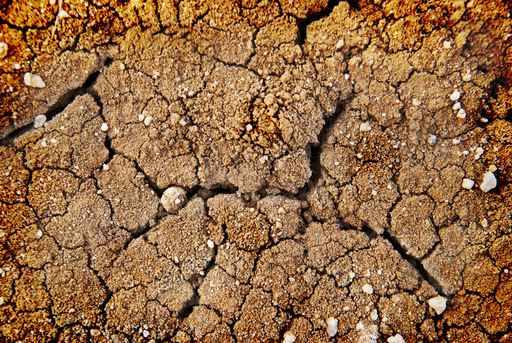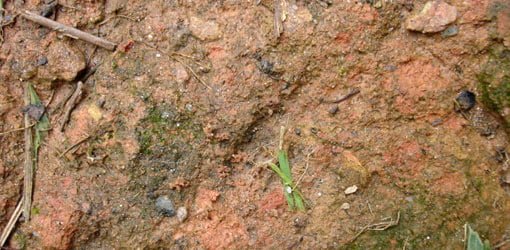Soil compaction is often a problem in field crop production and occurs when soil particles are pressed together, reducing available pore space for air and water. About half the soil volume is composed of particles, the other half is soil pores. At field capacity, these pores are roughly filled to equal parts with water and air. Pores are the spaces where roots grow, microbes live, and water and nutrients move through the soil.
For example, last spring we visited a dry bean field where there was about an acre of beans along a road that were stunted. When we checked the soil in the affected area, we found it was heavily compacted and root growth was reduced. The areas with healthy plant growth did not show soil compaction problems. Upon talking to the farmer, we learned that the affected area was where water pooled during heavy rains. This was further evidence that there was poor drainage and compacted soil in that part of the field.
In a wet year, however, heavy equipment compresses soil particles into smaller volumes, which provides less space for air and water to move through the soil. With larger equipment, wheel traffic compaction can occur to a considerable depth within the root zone, and becomes deeper as soil moisture content increases. In compacted soils, plant emergence can be reduced because of surface crusting. Plant roots are limited in their ability to take up required moisture and nutrients, and yields can suffer as a result.
Soil that is compacted can have dramatic affects on the productivity of berry plantings. A hardpan will restrict the movement of water down through the soil resulting in poor drainage. The depth of subsoiling should be no more than a few centimeters below the zone of compaction because any deeper uses more energy and risks the potential of deeper compaction.
The best time to subsoil is when the soil is dry, (e.g. August) so that the hardpan shatters. If subsoiling is done when the soil is too moist the hardpan will not be properly disrupted. A cover crop should be established after subsoiling to ensure that roots stabilize the cracks created. Every effort should be made to reduce tillage and traffic operations to prevent re-establishment of the compacted layer.
Where root growth is retarded or a greater amount of energy is required for roots to grow through compacted soil, production is usually reduced. After removing the compaction layer by deep ripping plant roots grow faster and deeper, increasing the amount of water and nutrients they can access, and as a result crop yield improves . The severity of the impact of subsurface compaction on root growth is dependent on many factors, primarily soil type and amount of compaction.
In sandy textured soils, roots slowed by moderate compaction are less effective at keeping up with water and dissolved nutrients, particularly nitrogen, as they infiltrate through the soil profile. The newly released "Cut Breaker" is a special subsoiler that can reach and break up deeper layers of compacted soil than the conventional subsoilers. It is a solution for fields with poor drainage caused by soil compaction.
Attached to tractors or bulldozers, the single to triple V-shaped blades cut into the soil in the depth of between 30 ~ 70 cm and break up the hardpan soil. It creates up to three rows of crushed soil, in size of 10 cm-width on the bottom and a maximum of 80 cm-width on the top. The soil inside these rows has enough air permeability, and the texture is loose enough to let the water go into the underground.
Improved soil condition promotes crop roots to grow and develop well, resulting in higher yield. The effect of the subsoil improvement using the "Cut Breaker" lasts for several years. Therefore, the treatment is appropriate for the fields with a long-term plan of growing crops other than rice. The easiest and most effective way to boost organic matter and improve soil quality in gardens or fields is to grow a cover crop in fall. Areas with hardpan or compacted soil are most improved by growing annual ryegrass as a cover crop or green manure. The dense roots of annual ryegrass can grow three to five feet deep and efficiently take up nitrogen and other nutrients for next spring's vegetable or ornamental plants.
Turn the annual ryegrass over into the ground in spring before the grass goes to seed. Deep tillage can improve crop production on what are often referred to as hardpan soils. Hardpan soils have a dense layer which has few, if any, large pores such as cracks and old root channels. Large soil pores are important for good water infiltration and root growth. When there are no large soil pores the infiltration of rainfall and snow melt is poor.
This results in water ponding at the soil surface and/or more water runoff, and thus, poor moisture conservation. Furthermore, the volume of soil that the plant roots can exploit for moisture and nutrients is restricted by the hardpan layer. Moisture and nutrient stresses of crops commonly occur in hardpan soils, particularly in dry years. Soil compaction occurs anytime equipment passes through a field. Ideally, the distribution of solids and pore space will be 50% mineral and organic matter, 25% air, and 25% water.
Compacted soils will have a higher percentage of solids and less pore space for air and water. The negative impacts of soil compaction include poor drainage, reduced seed germination, decreased root growth, decreased nutrient and water uptake, and overall reduced crop yield. No-till farming or gardening means that vegetables and other plants are grown without plowing or tilling the soil. This planting method helps to sequester carbon in the soil and therefore contributes to fighting climate change. The roots of annual ryegrass will grow through hardpan and compacted soil in winter, growing deeper each year.
The key word here is 'perennial', as green manures are annual plants. A 'living mulch' of low-growing perennial legumes can provide many advantages to the health of your orchard. First of all it can replace the grass which aggressively competes with your fruit trees for water and nutrients.
How Do You Break Up Hardpan Soil Hardpan can be identified through visual and mechanical clues. Hardpan, or compacted soil, is a barrier to growing grass, vegetable crops and other plants, because plants are unable to take up sufficient nutrients and water. However, some grasses have roots that can break up hardpan. Annual ryegrass (Lolium multiflorum spp.) is one of the most effective grasses in breaking up hardpan and compacted soil. Growing annual ryegrass improves soil drainage, adds organic matter to the soil and improves root development, facilitating nutrient and water uptake by plants.
One of the most common perceptions is that sunflower will break up hard pan soil compaction. It's true that sunflower roots have a stronger ability to break through compacted soils than other crops. And if sunflower has the proper condition to grow through the compaction layer, the plant leaves behind root residue channels that provide drainage and rooting paths for future cropping. Despite periods of extremely high temperatures, moderate droughts, and wet winters, clover planted on newly created food plots struggled some, but overall did well and survived all 3 years.
Because these food plots were "new" a hardpan was not present which allowed roots and water to penetrate deeper into the subsoil layers. During hot and drought-like conditions, clovers were able to utilize this deeper soil moisture to survive. Soil compaction can occur at the soil surface or in the subsoil.
Surface compaction is caused by water hitting tilled soil, which forms a crust. Compaction in the subsoil can be in the form of a hardpan layer or deep compaction. A hardpan forms when the tillage implement presses soil directly below it together, forming a compacted layer.
Deep compaction occurs further down in the soil profile and is caused by excessive weight on soil, particularly when soil is wet. It can be hard to break up soil once deep compaction occurs. Using newspaper and cardboard as an initial layer of mulch will dramatically increase the period of time before weeds start to show through.
A carpet of newspaper, part of the 'sheet mulch' technique, can be used where there are existing weeds and grasses, such as under a fruit tree. Then spread an organic fertiliser or compost, make sure the soil is moist. Next tile the area under the tree with paper or cardboard, from the trunk to just past the dripline. This is a good way to reduce household waste paper entering the waste stream and instead return the carbon to the soil. There is no advantage to weeding first because the weeds will decompose and add to the organic matter. Even better, the roots of the weeds will decompose and add organic matter deeper down in the soil.
The decomposed roots then become passageways through the soil for air and water to penetrate. Earthworms love the cardboard treatment and it encourages them to stay actively working to improve the soil for longer in the warmer weather rather than retreating to deeper, cooler areas. A compacted soil lacks the interconnected air spaces that are essential to the movement of water, gases and plant roots. Crop yields are most affected by compaction in dry years when plant roots, unable to penetrate compacted layers, cannot access much-needed subsoil water and nutrients. Water use efficiency is also greatly reduced as rain or irrigation water is unable to penetrate past the compacted layers of soil to refill the subsoil.
Cultivating compacted soils requires higher amounts of energy. This ratio of pore space and soil particles makes the issue of soil compaction easier to understand. Quite simply, compaction occurs when soil particles are pressed together and pore space is squeezed out of the soil. Without enough sizable pores, it can be difficult or nearly impossible for plant roots to grow and penetrate the soil. It can also be difficult for air, water, fertilizer and pesticide to infiltrate compacted soils, robbing plant roots of essential nutrients, water and oxygen. Deep ripping mechanically breaks up compacted soil layers, however care must be taken to ensure results are effective.
Deep ripping uses strong tines working down to 35-50cm depth to loosen hard layers of soil. Tine spacing, working depth, shallow leading tines or discs, soil moisture content, timing and soil type all need to be taken into account. Not all soils and crops respond positively to deep ripping every season.
Benefits usually last for about three seasons but can last more than 10 seasons with controlled traffic systems on light sands. Compaction is most likely to occur with heavier soils like clay and loam, but when heavy equipment is used, sandy soils can become compacted. These are soil particles that are packed closely together. The problem may be compounded by events that have happened to the soil over the course of years. The pore spaces are reduced to the point that air and water cannot move freely and plant roots cannot grow easily into the surrounding soil.
The soil could remain overly wet longer than is healthy for the plants growing there. Finally, gypsum can increase water infiltration in soils that are high in sodium but does not alleviate soil compaction. Sodium ions disrupt the clay structure in soil which causes the clay particles to destabilize and clog available pore space, resulting in slower water infiltration.
The calcium in gypsum will replace the sodium in the soil, which helps improve water infiltration. Therefore, gypsum can improve soil structure, but cannot reduce compaction of existing hardpans. Other management practices discussed above need to be implemented to improve and prevent soil compaction problems. Tillage is the first option for many people when it comes to reversing the effects of compaction. Deep tillage is able to break up hardpans, but the effect it has on yield is variable.
A hard pan is a compacted layer beneath the soil which very few roots can break through and is usually 1-2 inches thick. Also, be aware that continuous tillage like disking or plowing will cause a hardpan to develop just below the depth of the tillage and reduce soil structure. With the wide adoption of no-till equipment, many plows have been parked in the scrap yard. The Toussaints have soil pits around the farm to observe soil structure and rooting on the cover crops firsthand. Full-season cereal-rye roots extended 3 to 4 feet deep, breaking up hardpan layers, increasing aeration and water drainage, and building a bigger sponge to store water for late-summer reserve. Generally speaking, subsoiling every 2-3 years is recommended to benefit soils, keep hardpans from developing and enhance plant growth/survival in food plots.
A few areas that inevitably have soil compaction and benefit from subsoiling are logging decks and logging roads. It is not a coincidence that many food plots planted on logging decks appear stunted and are less productive than other food plots. When converting a logging deck or logging road into a food plot, the first step after clearing and cleaning the area up should be to subsoil.
Depending on soil types and conditions during the activity, skidders and other heavy equipment used during a logging operation can significantly compress underlying soils. If not addressed, food plot performance on logging decks or other compacted sites will be marginal at best. For a large vegetable garden, another solution is to grow a cover crop at the end of the season, then mow and turn in the following spring before planting. By mowing and turning the mowed tops in, the soil is additionally loosened.
Cover crops could include annual ryegrass, winter wheat, winter rye, buckwheat, oilseed radishes and hairy vetch. The more diverse the mix of cover crops and cash crops, the better the whole underground system works. The Toussaints follow small grains with a multispecies cover-crop mix of varying root depths and growing seasons.
Dwarf Essex rapeseed is popular because it germinates quickly and suppresses weeds, and its long, fibrous roots leave about a 16-inch root channel that reduces soil compaction. In loam, sandy clay loam and clay soil, a hardpan will often fracture into large clods when dug up which can only be broken with some force. Plant indicators include; poor root growth, swollen root tips and horizontal root growth as roots try to force their way through compacted soils. Roots growing through compacted soils can be confined to macropores, soil fractures or be at a reduced density.




























No comments:
Post a Comment
Note: Only a member of this blog may post a comment.